The Difference Between Electromagnets & Permanent Magnets
Magnets are usually classified as permanent and non-permanent magnets. Modern industry and everyday life rely heavily on magnetic fields. Magnets made of Neodymium Magnets (NdFeB), Samarium Cobalt (SmCo), AlNiCo, and Ferrite are generally referred to as permanent magnets, whereas electromagnets are commonly classed as non-permanent magnets. Despite both being magnetic and able to attract ferrous items, permanent magnets and electromagnets have different characteristics and offer different advantages.
Permanent Magnets & Electromagnets both create magnetic fields (which can be visualised by imaginary magnetic field lines). They will have North and South Poles, and both will have their magnetic fields interact with other sources of magnetic fields and materials which exhibit magnetic properties. However, Electromagnets are distinguished from permanent magnets by their ability to generate magnetic fields when electric current flows through them. In contrast, permanent magnets are as the name suggests, permanently magnetised. They do not need an electric current to generate magnetism.
The following is a simple comparison of Permanent Magnets versus Electromagnets:
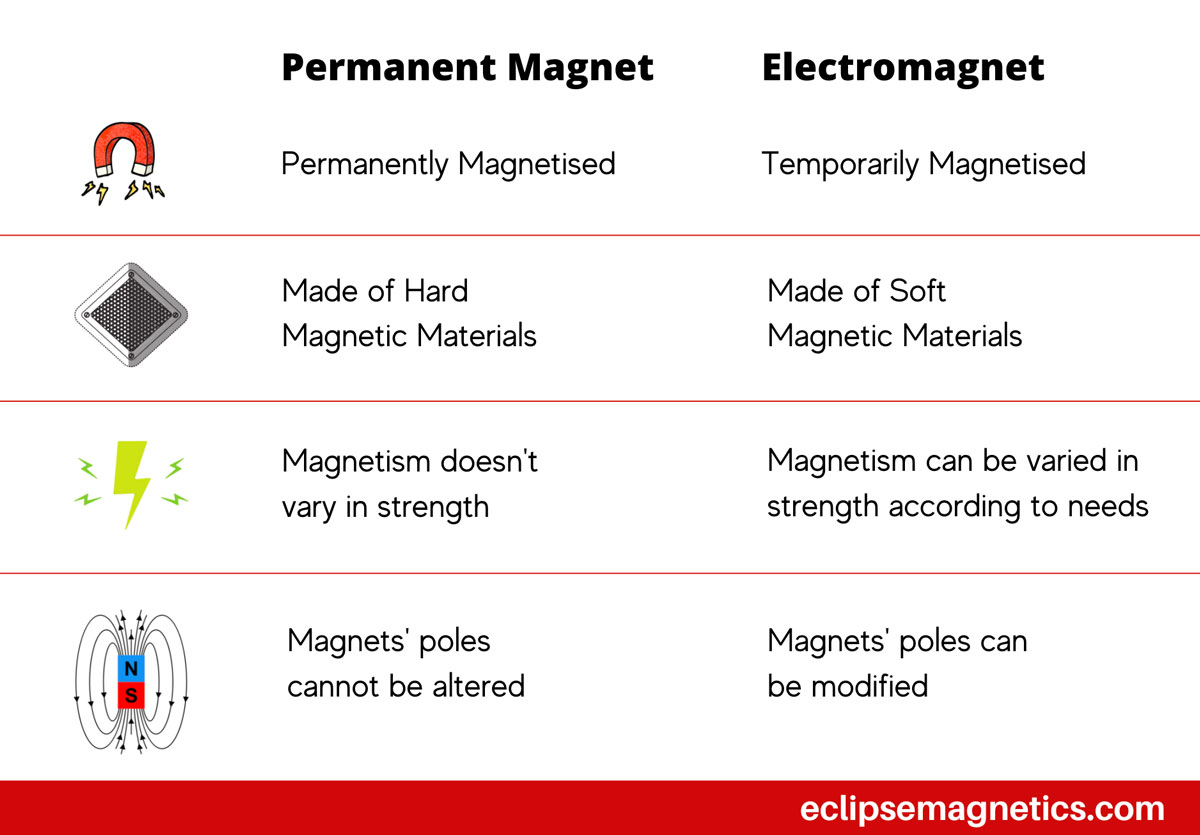
The exception to the above is Energise-to-Release Electromagnets (Electro-Permanent Magnets) – this is a specialised magnetic assembly that combines a permanent magnet within an electromagnet.
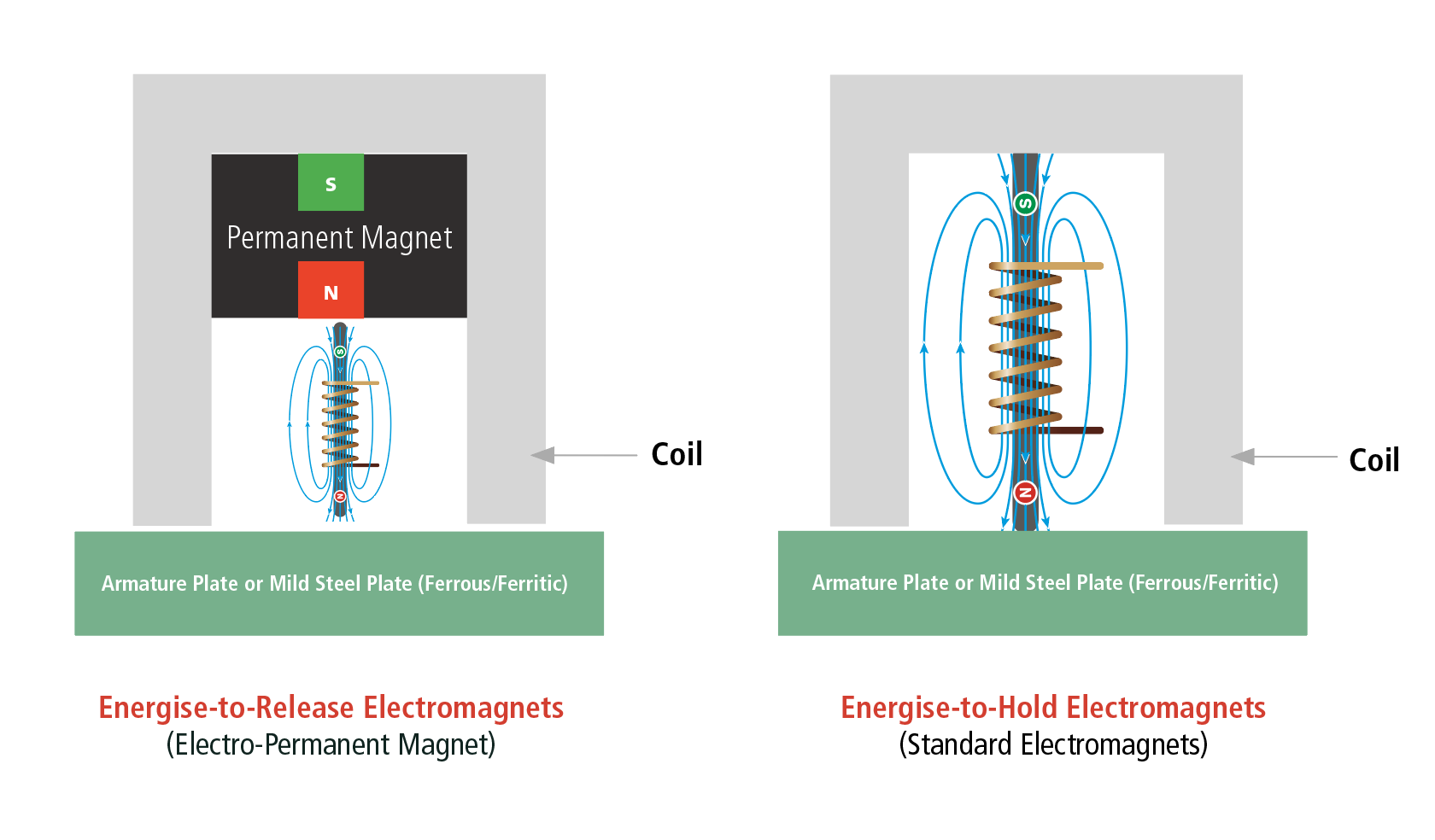
Permanent Magnet
Unlike other magnets that lose their magnetism over time, these types of magnets can retain their magnetism. Permanent magnets are composed of highly magnetised hard materials. Among the best examples of permanent magnets are bar magnets. This demonstrates typical magnetic behaviour.
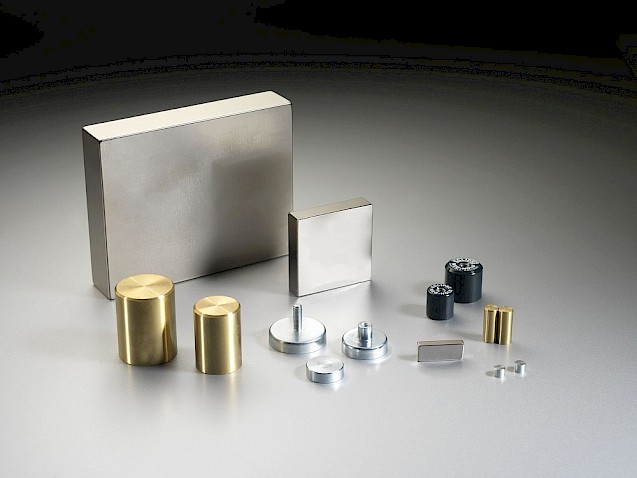
What are some uses of permanent magnets?
There are many uses for a permanent magnet. The most common application of a magnet is for the purpose of attracting other magnetic items, but it also has functions in electronic equipment. Permanent magnets are used in computers, motors, cars, generators, headphones, speakers, sensors, etc. Magnetic strips and fridge magnets are also common uses of permanent magnets.
Explore more related topics to Magnetism & Magnet Materials
Find the Right Magnet Materials: Alnico vs Neodymium Magnets
A Quick Guide to Magnets, Magnetic Metals and Non-Magnetic Metals
Electromagnet
An electromagnet usually has an iron core. Adding an iron core to a solenoid increases its magnetic field strength. In a connection between a battery and a solenoid by wounding wire around a nail, a magnetic force is generated. This happens due to the magnetic field created when current flows through the coil. As long as there is a d.c. current running through the coil, the nail's magnetic properties remain, but after that, the magnetism of the nail is lost. By winding wire around a core of iron, you are able to create electromagnets.
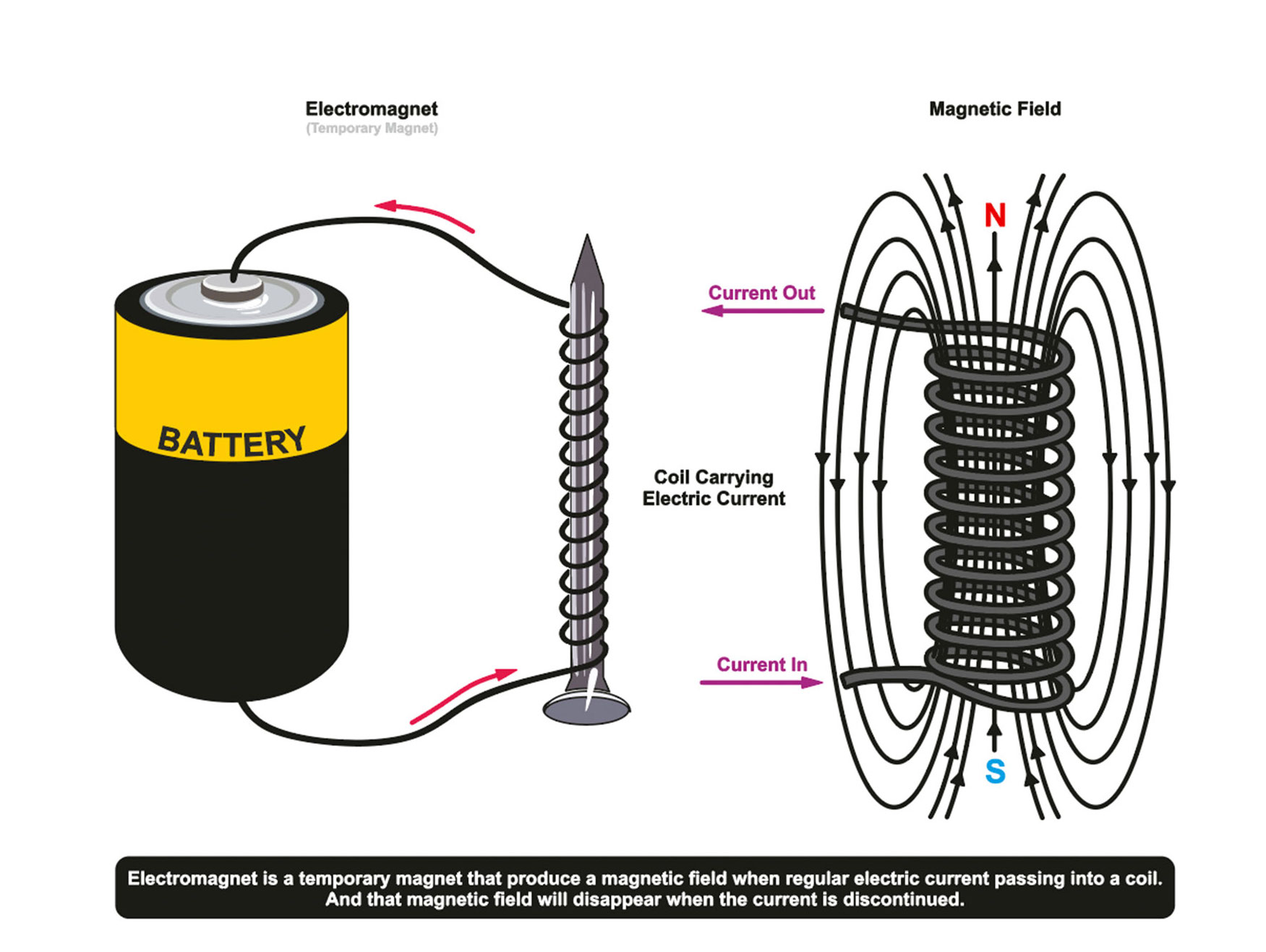
Electromagnets use electricity to generate magnetic flux. As opposed to permanent magnets, electromagnets can have their magnetic output easily adjusted by varying the amount of electricity flowing through them and unlike those with fixed magnetic output. Electromagnets are also able to have their poles reversed by reversing electricity flow by changing the direction of the electric current.
Current Density and Fill Factor
When making electromagnets you may end up creating a round wound coil (wound on a former/bobbin). Often the wire is round (has a diameter) so you cannot get a perfect filling of the space available for the wire. The amount you can actually occupy of the space available is called Fill Factor – this can be up to say 80% (remainder is air gaps) but it will vary with the design and wire type.
Then the wire type itself has an insulation layer (to prevent short circuits) but as each wire has a resistance per unit length and can conduct electricity the coil will have a I^2.R power loss which will always become heat. Each wire will have a heating rating e.g. 155 deg C. So you need to factor in cooling of components. But each wire also has a current density (how much current per unit cross sectional area of the wire) – you need to ensure the design does not exceed this as well to prevent dangerous damage to the wire. If the wire overheats it may start to burn out and the insulation gets damaged and fails.
Advantages of Electromagnets
The advantages of electromagnets over permanent magnets are numerous. As an example:
- You can turn them on and off
- A magnetic field can be adjusted in strength
Compared to permanent magnets, electromagnets can be, size for size, less expensive. The electromagnet is usually cheaper because fewer materials are used to make it. Depending on your needs, an Electromagnet's magnetic strength can be altered for the same design size. The same cannot easily be said for a permanent magnet.
What are some examples of Electromagnets
Electromagnets are used in a wide range of applications, from large-scale industrial machinery to small electronic components. A large amount of scientific research and experiments also make use of electromagnets, particularly when superconductivity and rapid acceleration are required. Electromagnetics are everywhere around you in day to day life – electric cars, vacuum cleaners, refrigerators, washing machines, tumble driers, food blenders, fan ovens, microwaves, dishwashers, hair dryers, fans, loudspeakers, etc – the list goes on and on!
More obvious electromagnet designs include:
Electric components: electronic doorbells and controllable electric locks.
Music equipment: loudspeakers, earphones, tape recorders, and magnetic recording.
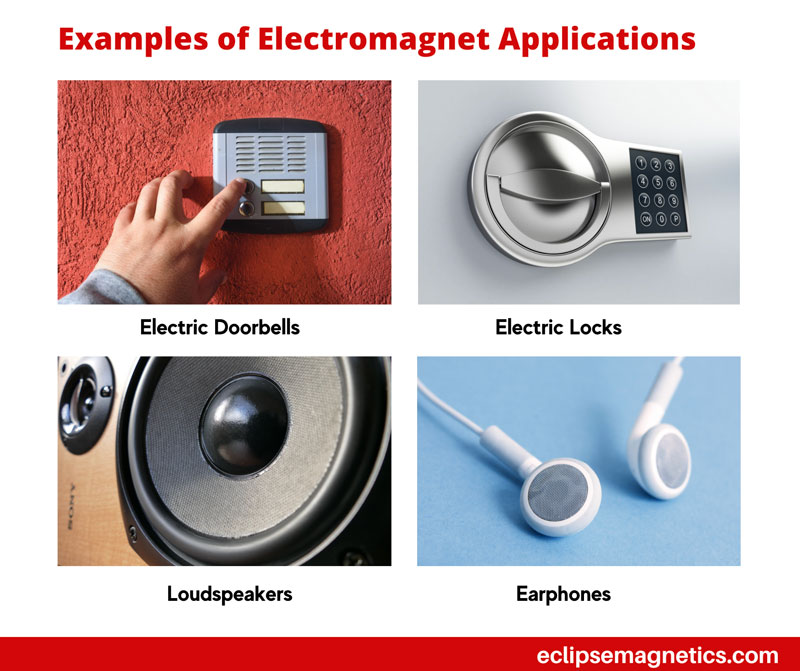
Types of Electromagnets We Design & Supply
Standard Electromagnets (Energise-to-Hold Electromagnets/Electro-holding magnets)
The Energise-to-Hold Electromagnet clamps only for as long as the electric current is applied. Energise it and it holds; as soon as the current is turned off, the electromagnet stops clamping. The Energise-to-Hold electromagnet is a standard electromagnet concept – a solenoid (wound copper coil) within a high quality high permeability iron assembly for high clamping forces and low magnetic losses. The iron cylinder of the Energise-to-Hold Electromagnet is of sturdy design with a bright nickel finish passivated with body mounting.
The Energise-to-Hold Electromagnet has three styles of electrical connection:
Free leads
Two-pole connector
Hirschman connectors.
The Energise-to-Hold electromagnet has, depending on the size, three supply voltages:
12V dc
24V dc
240V ac
The Energise-to-Hold Electromagnet has an ED rating of 100% and an IP rating of 54 (20 for the two-pole connector version). The Energise-to-Hold Electromagnets have maximum possible pull force ratings from 52N up to 3600N (5.2kg to 360kg) depending on the size of the unit (the actual pull achieved is application dependent).
Advantages of Energise-to-Hold Electromagnets
Only clamps while an electric current is present
Variable clamping force possible from varying the current
High magnetic clamping forces possible
Easy On-Off operation
Remote Operation possible
Can mount in parallel connection for multiplying the holding force
Versatile mounting arrangement
Can clamp to any ferrous surface (maximum pull achieved with recommended armature plates)
Is possible to tune the amount of pull force by varying the current instead of applying full current (not recommended)
Surrounding stray magnetic field is reduced due to design
Electro-Permanent Magnet (Energise-to-Release Electropermanent)
The Energise-to-Release Electromagnet is an electro-permanent concept – a solenoid (wound copper coil) plus a magnet both within a high-quality high permeability iron assembly for high clamping forces and low magnetic losses. The unit clamps and only releases when a current is applied. The iron cylinder of the Energise-to-Release Electromagnet is of sturdy design with a bright nickel finish passivated with body mounting.
Armature plates (Keeper plates) exist to suit each Energise-to-Release Electromagnet unit.
The Energise-to-Release Electromagnet has two styles of electrical connection:
Hirschman connectors
Hirschman style connectors.
The Energise-to-Release electromagnet has, depending on the size, two supply voltages: - 24V dc and 240V ac. The Energise-to-Release Electromagnet has a Duty Cycle of S2 and an IP rating of 54. The Energise-to-Release Electromagnets have maximum possible pull force ratings from 230N up to 550N (23kg to 55kg) depending on the size of the unit (the actual pull achieved is application dependent). They are popular safety devices. They stay clamped in power outages.
Advantages of Energise-to-Release Electromagnets
If no current is present, the unit will clamp to a ferrous surface using the internal magnet
Energy efficient – unit releases the hold only when you apply an electric current
Secure hold – does not need a current to clamp
Can be operated remotely
Versatile mounting arrangement
Can clamp to any ferrous surface (maximum pull achieved with recommended armature plates)
Can mount in parallel connection for multiplying the holding force
Is possible to tune down the pull force by varying the applied current instead of applying full current (not recommended)
Common Applications
Fire and security doors
Robotic
Machine guards
Moving and lifting ferrous objects
Armature Plates for Electromagnets
The armature plates are quality ferromagnetic plates with fixing holes sized to suit both the Energise-to-Hold Electromagnet and the Energise-to-Release Electropermanent magnet. They are used to get the best clamping performance from the electromagnets and electro-permanent magnets.
They are used when either no ferromagnetic material exists for the electromagnets to clamp onto or where the existing ferromagnetic surface is not ideal for best clamping (e.g. thin sheet, rusty steel, curved surfaces). They are sometimes also referred to as Keeper Plates.
The armature plates have rubber washers supplied with them to allow for a small degree of flex in their movement (at the back) to maximise direct contact (by allowing minimum air gap) to the electromagnet clamping face to allow maximum possible pull forces to be achieved.
Electromagnet/Solenoid Assemblies
We can supply assemblies and sub-assemblies to customer design drawings. Please contact us to arrange a visit, request a quotation or to get technical support and design help.


 UK
UK